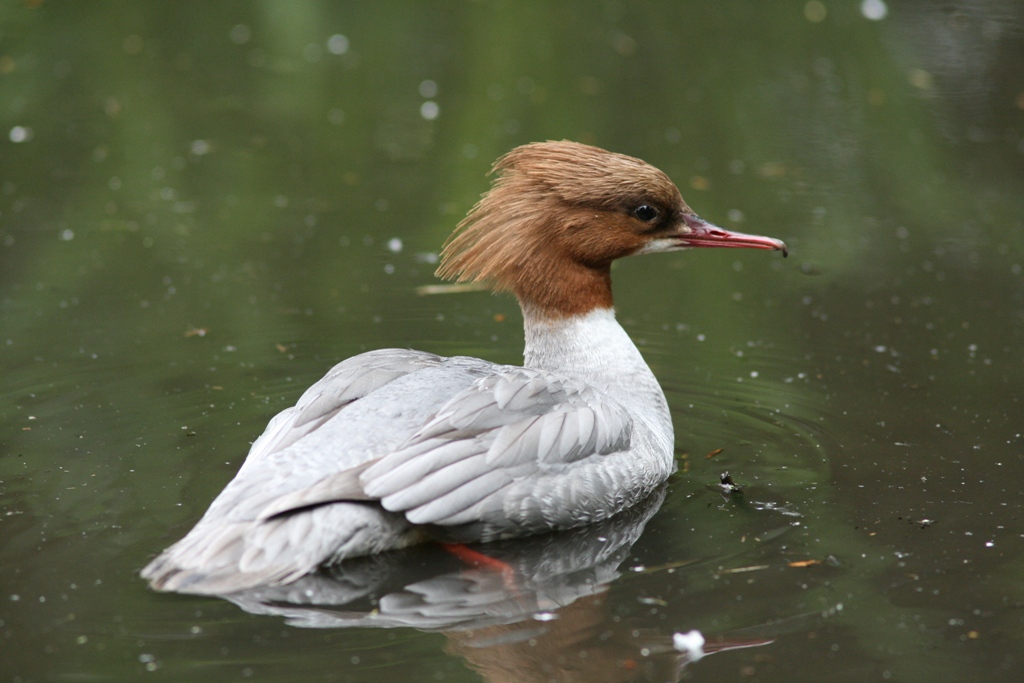
Common merganser, or Goosander(Mergus merganser)
Phylum —chordata
Class — aves
Order — anseriformes
Family — anatidae
Genus –mergus
Appearance
It is 58–72 cm (23–28 in) long with a 78–97 cm (31–38 in) wingspan and a weight of 0.9–2.1 kg (2.0–4.6 lb); males average slightly larger than females but with some overlap.
Like other species in the genus Mergus, it has a crest of longer head feathers, but these usually lie smoothly rounded behind the head, not normally forming an erect crest. Adult males in breeding plumage are easily distinguished, the body white with a variable salmon-pink tinge, the head black with an iridescent green gloss, the rump and tail grey, and the wings largely white on the inner half, black on the outer half. Females, and males in "eclipse" (non-breeding plumage, July to October) are largely grey, with a reddish-brown head, white chin, and white secondary feathers on the wing. Juveniles (both sexes) are similar to adult females but also show a short black-edged white stripe between the eye and bill. The bill and legs are red to brownish-red, brightest on adult males, dullest on juveniles.
Habitat
Common mergansers occur in both the Nearctic and Palearctic regions. In North America, common mergansers may breed as far north as southern Alaska and Canada. Some occur year-round in the northern and western United States. North American birds winter in New England, midwestern and southern states, and the Pacific coast of the U.S. and Canada. Common mergansers in the Palearctic region typically breed in northern Europe, Scandinavia, throughout Russia, and in much of northern Asia. Populations in Europe winter along the coasts of Scandinavia and northern Europe, as well as parts of the northern Mediterranean coast and north Africa. In Asia common mergansers winter in southern Asia, northern India, Japan, China, and Korea.
Behavior
Mergus merganser is a social species, preferring to be in groups of up to 75 individuals. Nest sites are usually isolated, but females sometimes nest in close proximity or even in the same tree. Broods often intermix, producing mixed broods of up to 40 or more young, tended by one or more adult females. In the winter, huge gatherings of hundreds of individuals have been observed. Birds in flocks tend to maintain regular spacing in flight, but on the water large groups will distribute irregularly, with pairs remaining close.
Common mergansers fly individually, in pairs, or in small flocks. They typically fly at about 70 km/h, and hold the head, body, and legs in one horizontal line. Females easily maneuver between trees in search of nesting sites, but flight is typically either low and along waterways or high and directional.
Common mergansers swim along the surface of clear shallow waters, paddling alternately, with their heads submerged in order to see their prey. Their dive is preceded by a slight leap.
Diet
Common mergansers are skilled diving predators, eating mainly slower small fish.
Reproduction
Nesting is normally in a tree cavity, so it requires mature forest as its breeding habitat; they also readily use large nest boxes where provided, requiring an entrance hole 15 cm (5.9 in) in diameter. In places devoid of trees (like Central Asian mountains), they use holes in cliffs and steep, high banks, sometimes at considerable distances from the water. The female lays 6–17 (most often 8–12) white to yellowish eggs, and raises one brood in a season. The ducklings are taken by their mother in her bill to rivers or lakes immediately after hatching, where they feed on freshwater invertebrates and small fish fry, fledging when 60–70 days old. The young are sexually mature at the age of two years.
The record for the oldest common merganser is held at 13 years 5 months.
In captivity
Knowing the basics of living common mergansers in the wild, you can easily arrange life for them on a private farm. It should be taken into account that the breed is not suitable for permanent residence in hot climatic zones. With a large amount of fat, the ducks will begin to suffer from the heat. The temperate climate suits such ducks as well as possible. In cold areas, you can also create conditions by providing seasonal heating. In general, the common mergansers are unpretentious, do not require too careful, annoying care, do not need exotics.
Wild ducks are extremely freedom-loving. They move around a lot, so it's a must. There should not be more than 3 adults per 1 m2 of space. The building is made at least 16 m2, even for the residence of ten or even twelve ducks. Crowding causes stress, leads to slow growth, diseases and fights.
Common mergansers need regular walking in the fresh air. They should walk daily and do not depend on season. Exceptions are made only for days with a cold snap below -10 oC, when there is a risk of frostbite. Some farmers prudently make a ground with the possibility of winter insulation, removable walls and a roof.
The diet of a common merganser is as close as possible to the natural one. This is especially true for birds who were taken on the farm in adulthood. Their diet includes raw and boiled fish of various kind, algae, a small amount of dried and fresh larvae, meadow grass.
 Russian
Russian
 English
English
























